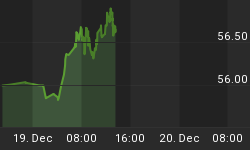Investor sentiment is neither bullish nor bearish, and I think this presents a problem for the bulls. First, the lack of bears implies little short covering, which is fuel for any rally. Second, the lack of bulls at this stage of the rally should be disconcerting. The market fell apart in August, stabilized in September, went bananas in October, and has gone sideways in November. Prices on the SP500 have closed below the 40 week moving average for 18 out of the last 19 weeks. The bulls really aren't buying it. While too many bulls is normally a headwind for higher prices, coming out of a deep sell off, like we had in August, there should be too many bulls as prices move higher. But there is a lack of speculative buying from this market. A close over the 40 week moving average along with strong buying interest would likely change this dynamic, and until that happens, I remain bearish!
The "Dumb Money" indicator (see figure 1) looks for extremes in the data from 4 different groups of investors who historically have been wrong on the market: 1) Investors Intelligence; 2) MarketVane; 3) American Association of Individual Investors; and 4) the put call ratio. This indicator shows neutral sentiment.
Figure 1. "Dumb Money"/ weekly
Figure 2 is a weekly chart of the SP500 with the InsiderScore "entire market" value in the lower panel. From the InsiderScore weekly report: "Pushed to the sidelines a week earlier, sellers reemerged in full force this past week, pushing one of our main sentiment indicators, the Weekly Score, to its worst level since the week ended May 27, 2011 (or two weeks after the market's three-year high) as the number of sellers jumped ~145% week-over-week."
Figure 2. InsiderScore "Entire Market" value/ weekly
Figure 3 is a weekly chart of the SP500. The indicator in the lower panel measures all the assets in the Rydex bullish oriented equity funds divided by the sum of assets in the bullish oriented equity funds plus the assets in the bearish oriented equity funds. When the indicator is green, the value is low and there is fear in the market; this is where market bottoms are forged. When the indicator is red, there is complacency in the market. There are too many bulls and this is when market advances stall. Currently, the value of the indicator is 57.70%. Values less than 50% are associated with market bottoms. Values greater than 58% are associated with market tops.
Figure 3. Rydex Total Bull v. Total Bear/ weekly
Let me also remind readers that we are offering a 1 month FREE TRIAL to our Daily Sentiment Report (formerly Premium Content), which focuses on daily market sentiment and the Rydex asset data. This is excellent data based upon real assets not opinions! We have a new 1-click sign up process! Credit cards are not required.
TheTechnicalTake offers a FREE e-newsletter: HERE.















